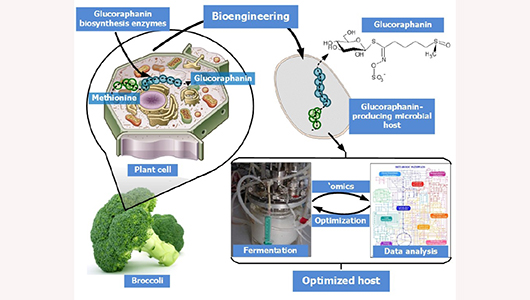
Engineering production of health-promoting glucoraphanin in microbial cell factory
Intake of glucosinolates via consumption of cruciferous vegetables (e.g. broccoli and cabbages) has been associated with numerous health benefits as well as prebiotic effects. Glucoraphanin is the major glucosinolate associated with the health-promoting effects in broccoli. To obtain the beneficial effects requires intake of high amounts of broccoli, which has primed a desire to develop microbial production of dietary glucoraphanin supplements as stable, rich source.
Glucoraphanin biosynthetic pathway consists of two sub-pathways. First, a 5-genes chain elongation pathway converts methionine to dihomomethionine by two consecutive additions of a methylene group. Secondly, an 8-genes core glucosinolate structure pathway converts dihomomethionine to the corresponding glucoraphanin. All genes in the pathways have been identified. In Nicotiana benthamiana, we have demonstrated the feasibility of engineering glucoraphanin in a heterologous host.
We are exploiting both bacteria and yeast as microbial host organisms. In yeast, we have established a versatile platform for stable integration into the genome of complex multi-gene pathways. As proof-of-concept, we successfully engineered production of indolic and benzyl glucosinolates. In E.coli, we have obtained production of dihomomethionine. In our microorganisms, we will combine both pathway and transport engineering strategies to obtain cost-efficient, microbial production of glucoraphanin.
Petersen A, Hansen LG, Mirza N, Crocoll C, Mirza OA, Halkier BA (2019) Changing substrate specificity and iteration of amino acid chain elongation in glucosinolate biosynthesis through targeted mutagenesis of Arabidopsis methylthioalkylmalate synthase. Biosci Rep. DOI: 10.1042/BSR20190446
Petersen A, Crocoll C, Halkier BA (2019) De novo production of benzyl glucosinolate in Escherichia coli. Metab Eng 54, 24–34. DOI:10.1016/j.ymben.2019.02.004
Petersen A, Wang C, Crocoll C, Halkier BA (2018) Biotechnological approaches in glucosinolate production. JIPB. DOI: 10.1111/jipb.12705
Mirza N, Crocoll C, Erik Olsen C, Ann Halkier B (2016) Engineering of methionine chain elongation part of glucoraphanin pathway in E. coli. Metab Eng 35: 31–37. DOI: 10.1016/j.ymben.2015.09.012
Crocoll C, Mirza N, Reichelt M, Gershenzon J, Halkier BA (2016) Optimization of engineered production of the glucoraphanin precursor dihomomethionine inNicotiana benthamiana. Frontiers in bioengineering and biotechnology 4: 14. DOI: 10.3389/fbioe.2016.00014
Mikkelsen MD, Buron LD, Salomonsen B, Olsen CE, Hansen BG, Mortensen UH, Halkier BA (2012) Microbial production of indolylglucosinolate through engineering of a multi-gene pathway in a versatile yeast expression platform. Metab Eng 14: 104–111. DOI: 10.1016/j.ymben.2012.01.006
Contact person
 |
Professor |
